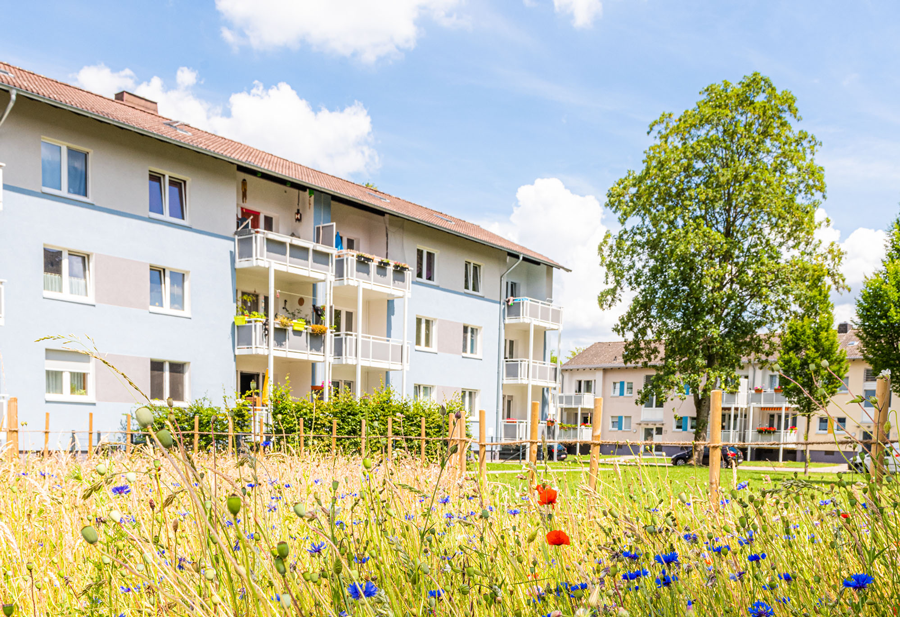Society and Contribution to Urban Development
GRI
103-1
103-2
103-3
203-1
UNGC
Principle 1
Disclosure
The social megatrends of climate change, urbanization and demographic change set out the scope for change within which the housing industry needs to find services and solutions. From ensuring that our portfolio is climate-neutral (see Environmental Issues), increasing levels of urbanization and tenants having an increasingly wide range of requirements (see Fairly Priced Housing) to our aging society (see Needs-based Housing (Demographic Change)), the challenges that we face are becoming increasingly complex and intertwined. That is why the environment in which people live and their neighborhoods are becoming an increasingly important focus area for the residential real estate industry – a trend that has been given significant impetus by the coronavirus pandemic.
Quality of living has more and more to do with what is going on at a neighborhood level; people want to identify with where they live and feel at ease in their environment. A balanced mix of rented apartments and condominiums, the integration of small businesses, attractive open and communal spaces, the availability of local suppliers, modern transport connections and mobility, good educational facilities, and social and cultural facilities – the interplay of all these factors promotes diverse and vibrant neighborhoods. This is an aspect that is also becoming increasingly important to tenants. In this way, the real estate industry is also partaking in urban development and is able to contribute its own expertise to the design processes through direct contact with tenants.
- Holistic orientation of future community development projects while taking our environmental and social responsibilities seriously
- Portfolio segmentation aligned with neighborhood approach: around 70% of portfolio located in areas that make up “urban quarters”
- 15 community development projects with around 8,600 residential units under implementation (investment volume of € 61.6 million), 20 more in the pipeline
- Internal knowledge management for neighborhoods (Neighborhood Academy and Vonovia Neighborhood Guide)
- Urgent assistance totaling over € 400,000 provided in response to catastrophic flooding in Germany, employees involved directly
- Grants for social/cultural projects and facilities of around € 1.5 million
Neighborhoods bring together stakeholders with different interests, including through varied ownership and tenant structures. In order to feel at home, many people want to be involved in decisions that will have an impact on the environment around their homes. Participation measures are therefore becoming increasingly important to strengthen acceptance for community development and the associated, often long-term, measures. Our experience shows that participation processes can achieve even better results by incorporating new and varying points of view and by integrating them into decision-making processes. The complexity and probability of not being able to fulfill all stakeholder wishes equally also increases.
Focusing on providing holistic solutions at a neighborhood level makes it possible to align urban development specifically with social and ecological needs and to exploit synergies. Innovative solutions that enable buildings to be networked together are especially important if climate protection targets are to be achieved. Social cohesion can only be achieved by looking outside of one’s own front door and towards the neighborhood.
The social infrastructure of a neighborhood therefore plays an important role in social cohesion. A cohesive civil society with all its social and cultural offerings creates space for diversity and contributes significantly to the attractiveness and liveliness of neighborhoods. Social institutions and civic engagement support exchange and thus successful coexistence in local communities.
It is of the utmost importance that tenants, residents and local politicians have a high level of acceptance for all changes made in neighborhoods. This goes without saying when you consider that we help shape people’s immediate living environment. We need to inform residents about planned measures in good time so that they have an opportunity to voice their worries and concerns. Involving people in the community provides us with a significant opportunity to improve our neighborhoods together and make a positive contribution to cohesion. Open and transparent communication with municipal authorities also has a crucial role to play in the success of urban development projects.
We have identified Community Development and Contribution to Infrastructure as a material topic. This is complemented by the important topics of integration, diversity and social cohesion, involvement and participation and shaping political dialogue, all of which play an important part in our neighborhood approach. The section below provides information about our approach, the steps we have taken to integrate this approach into our processes and our targets and measures related to the material topic.


